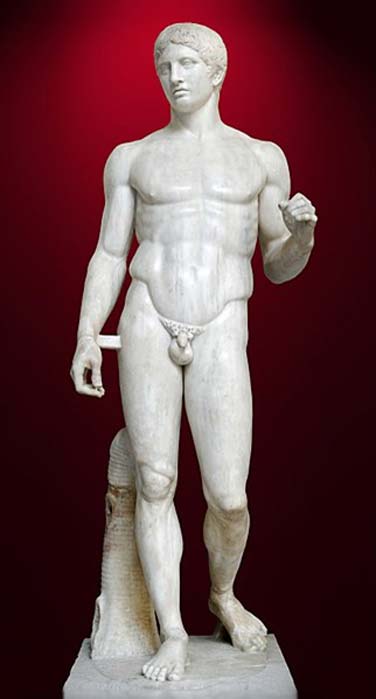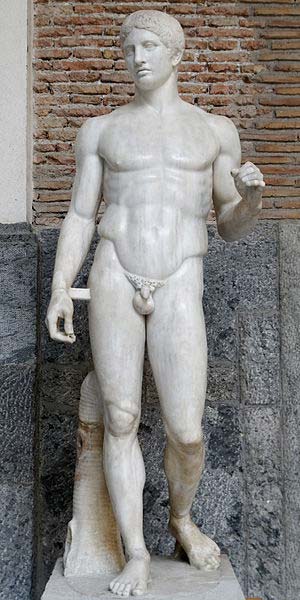
Doryphoros: Greek Art Imitating Ideal Form
Was perfection possible in the ancient Greek world? If you look at their art, you may think so. Doryphoros (translated from Greek as ‘Spear-Bearer), was a statue created during the 5th century BC. The fine detail for an idealized human anatomy and natural pose of this statue inspired Romans to create several copies and lucky for us, some of the replicas have survived until today.
The Doryphoros’ creator, Polykleitos, is regarded as one of the most important sculptors of classical antiquity and was also the author of a treatise known as the Kanon (or Canon, which means ‘measure’ or rule’). This treatise, like the original Doryphoros sculpture, is no longer in existence, but it has been referred to by other writers from the ancient world, such as Galen and Pliny.

A Roman copy of the Doryphoros, Naples National Archaeology Museum. (CC BY 2.5)
Expressing Anatomy in Ratios
We know that this treatise expounded the sculptor’s view on the ideal proportions of the human body as expressed in mathematical ratios. A summary of this treatise is provided by Galen,
“Chrysippos holds beauty to consist not in the commensurability or "symmetria" [i.e. proportions] of the constituent elements [of the body], but in the commensurability of the parts, such as that of finger to finger, and of all the fingers to the palm and wrist, and of those to the forearm, and of the forearm to the upper arm, and in fact, of everything to everything else, just as it is written in the Canon of Polyclitus.”
- Wonder of the Ancient World: The Grand and Powerful Statue of Zeus
- Will It Work? Greece Is Willing to Loan Archaeological Treasures in Exchange for the Parthenon Marbles
- Rare bronze statue of Greek god Apollo appears in Gaza
Galen goes on to mention that Polykleitos supported his treatise by creating a statue that adhered to the principles written in the Kanon, and it is believed that the Doryphoros is said statue. Like most free-standing sculptures produced by the ancient Greeks, it was made of bronze. Due to the high value of this metal, it was frequently melted and reused, most often as weapons. It is likely that the original statue suffered this fate.

Bronze fragments of an ancient Greek club (vertical position on the left) and spears (horizontally positioned on the right). (CC BY SA 3.0)
Roman Copies of the Doryphoros
Be that as it may, this was a famous statue, and copies of it were made during the Hellenistic and Roman periods. The best-known copies were made by Roman sculptors in marble and it is from these works of art that we are able to gain some understanding of Polykleitos’ masterpiece.
Several Roman copies of the sculpture have been found, though these are of varying quality and completeness. The best-known copy is one that was found in Pompeii. Today it’s exhibited in the Naples National Archaeology Museum in Italy. From this marble copy, we know that the artwork depicted a solid-built athlete or warrior carrying a spear which was balanced on his left shoulder.

Doryphoros from Pompeii. (Marie-Lan Nguyen/CC BY 2.5)
Striving for Perfection
Apart from its proportions, the statue is also noted for its contrapposto (which means ‘counterpoise’) stance. This pose is achieved by placing more weight on one leg, which causes the rest of the body to react in such a way that balance may be attained. In the Doryphoros, its right hip goes up and right shoulder lowers, due to the added weight on its right leg. The opposite is true for its left side. The result of this is a more natural, dynamic work of art.
- Britomartis: The Original Virgin Huntress
- A More Colorful Ancient Greece: Pigment Proves Classical Statues Were Once Painted
- Stunning Minoan Gemstone Owned by a Bronze Age Warrior Rewrites the History of Ancient Greek Art
Lastly, it may be remarked that whilst the Doryphoros may be regarded as a representation of the marriage between the human form and mathematical ratios, it may also be seen as an idealized version of the former.
This idealism is not only seen in the proportions of the body parts of the sculpture, but also in its facial expression, which is devoid of individual features, hence representing the perfect version of a citizen of the ancient Greek city states. In a way, it may be said that the statue reflects the ancient Greek obsession with striving for perfection, though this was accompanied by the awareness of its impossibility.

Face of the Doryphoros from Pompeii. (Marie-Lan Nguyen/CC BY 2.5)
Top Image: Detail of a copy of the Doryphoros of Polykleitos. Source: Nick Thompson/CC BY NC 2.0
By Wu Mingren
References
Annenberg Foundation, 2017. Doryphoros (Canon). [Online]
Available at: https://www.learner.org/courses/globalart/work/138/index.html
Harris, B. & Zucker, S., 2015. Polykleitos, Doryphoros (Spear-Bearer). [Online]
Available at: https://smarthistory.org/polykleitos-doryphoros-spear-bearer/
Museum of Classical Archaeology Databases, University of Cambridge, 2018. Doryphoros. [Online]
Available at: http://museum.classics.cam.ac.uk/collections/casts/doryphoros-0
penelope.uchicago.edu, 2018. Doryphoros. [Online]
Available at: http://penelope.uchicago.edu/~grout/encyclopaedia_romana/miscellanea/museums/doryphoros.html
Slater Memorial Museum, Norwich Free Academy, 2018. The Doryphoros or Spear-Bearer. [Online]
Available at: https://www.slatermuseum.org/cast/the-doryphoros-or-spear-bearer/
The Art Minute: Short Lessons in Art History, 2013. The Doryphoros: He’s Kind of a Big Deal. [Online]
Available at: http://www.the-art-minute.com/the-doryphoros-hes-kind-of-a-big-deal/
Tufano, E., 2018. The Doryphoros of Polykleitos at the Archaeological Museum of Naples. [Online]
Available at: https://pompeiitourguide.me/2013/04/30/the-doriforo/















